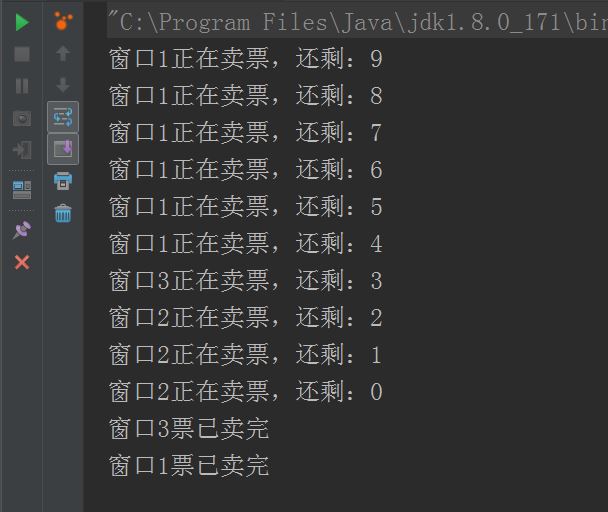java多线程笔记--synchronized类,对象,方法,代码块
Posted SingleOneMan
tags:
篇首语:本文由小常识网(cha138.com)小编为大家整理,主要介绍了java多线程笔记--synchronized类,对象,方法,代码块相关的知识,希望对你有一定的参考价值。
java多线程笔记–synchronized的用法
文章目录
* 0)对象锁是用于对象实例方法,或者一个对象实例上的, * 类锁是用于类的静态方法或者一个类的class对象上的(单例模式的双重检测) * 一个线程获得对象锁的同时,也可以获得该类锁,即同时获得两个锁 * 1)synchronized类,和synchronized对象(this) * //synchronized(this)代表锁住同一对象。多个线程竞争锁访问同一对象,对不同对象不竞争 * //synchronized(CountRunnable.class)代表锁住整个CountRunnable类的对象。多个线程对同一类的多个对象也竞争锁访问 * 2)synchronized方法和synchronized代码块 * 同步代码块比同步方法粒度小;一般需要加锁进行同步的时候,肯定是范围越小越好,这样性能更好 * synchronized方法和synchronized代码块(synchronized(this))都是锁当前对象 * 3)当一个线程访问object的一个synchronized(this)同步代码块时, * 另一个线程仍然可以访问该object中的非synchronized(this)同步代码块 * 4)线程访问synchronized内的代码时,会隐式地获取锁,执行完括号中的代码,会隐式地释放锁
1.锁对象, 多线程售票示例
package com.ctg.test.thread;
/**
* @Description: 1)synchronized 类
* 2)synchronized对象(this)
* 3)synchronized方法
* 4)synchronized代码块
* @Author:
* @Date: 2019/5/22 21:48
*/
public class TestSynchronizedTicket
private static int num = 10;
public static void main(String[] args)
TicketRunnable ticketRunnable = new TicketRunnable(num);
Thread t1 = new Thread(ticketRunnable, "窗口1");
Thread t2 = new Thread(ticketRunnable, "窗口2");
Thread t3 = new Thread(ticketRunnable, "窗口3");
t1.start();
t2.start();
t3.start();
public static class TicketRunnable implements Runnable
private int ticket;
public TicketRunnable(int ticket)
this.ticket = ticket;
@Override
public void run()
while (ticket > 0)
//锁对象,多个线程竞争访问同一个对象TicketRunnable ticketRunnable = new TicketRunnable(num)
synchronized (this)
if (ticket > 0)
try
ticket--;
Thread.sleep(100);
catch (Exception e)
e.printStackTrace();
System.out.println(Thread.currentThread().getName() + "正在卖票,还剩:" + ticket);
else
System.out.println(Thread.currentThread().getName() + "票已卖完" );

2.synchronized类,对象,方法,代码块示例
package com.ctg.test.thread;
import java.text.SimpleDateFormat;
import java.util.Date;
/**
* @Description:
* @Author:
* @Date: 2019/5/22 23:34
*/
public class Service
//类锁,锁 静态方法,和f2 f3不竞争
public static synchronized void f0()
SimpleDateFormat df = new SimpleDateFormat("yyyy-MM-dd HH:mm:ss");//设置日期格式
System.out.println(df.format(new Date())+";"+Thread.currentThread().getName()+":"+"f0");
try
Thread.sleep(1000);
catch (InterruptedException e)
e.printStackTrace();
//类锁,锁 类.class,和f2 f3不竞争
public void f1()
synchronized (Service.class)
SimpleDateFormat df = new SimpleDateFormat("yyyy-MM-dd HH:mm:ss");//设置日期格式
System.out.println(df.format(new Date())+";"+Thread.currentThread().getName()+":"+"f1");
try
Thread.sleep(1000);
catch (InterruptedException e)
e.printStackTrace();
//锁方法,f2 f3竞争(锁的也是当前对象)
public synchronized void f2()
SimpleDateFormat df = new SimpleDateFormat("yyyy-MM-dd HH:mm:ss");//设置日期格式
System.out.println(df.format(new Date())+";"+Thread.currentThread().getName()+":"+"f2");
try
Thread.sleep(1000);
catch (InterruptedException e)
e.printStackTrace();
//锁代码块,f2 f3竞争,如果用了同步代码块,那么当退出代码块时就已经释放了对象锁(当前对象this进行加锁)
public void f3()
//
synchronized (this)
SimpleDateFormat df = new SimpleDateFormat("yyyy-MM-dd HH:mm:ss");//设置日期格式
System.out.println(df.format(new Date())+";"+Thread.currentThread().getName()+":"+"f3");
try
Thread.sleep(1000);
catch (InterruptedException e)
e.printStackTrace();
//
//锁普通对象,跟f2 f3不竞争
public void f4()
String str="test";
synchronized (str)
SimpleDateFormat df = new SimpleDateFormat("yyyy-MM-dd HH:mm:ss");//设置日期格式
System.out.println(df.format(new Date())+";"+Thread.currentThread().getName()+":"+"f4");
测试:
package com.ctg.test.thread;
/**
* @Description:
* 0)对象锁是用于对象实例方法,或者一个对象实例上的,
* 类锁是用于类的静态方法或者一个类的class对象上的(单例模式的双重检测)
* 一个线程获得对象锁的同时,也可以获得该类锁,即同时获得两个锁
* 1)synchronized类,和synchronized对象(this)
* //synchronized(this)代表锁住同一对象。多个线程竞争锁访问同一对象,对不同对象不竞争
* //synchronized(CountRunnable.class)代表锁住整个CountRunnable类的对象。多个线程对同一类的多个对象也竞争锁访问
* 2)synchronized方法和synchronized代码块
* 同步代码块比同步方法粒度小;一般需要加锁进行同步的时候,肯定是范围越小越好,这样性能更好
* synchronized方法和synchronized代码块(synchronized(this))都是锁当前对象
* 3)当一个线程访问object的一个synchronized(this)同步代码块时,
* 另一个线程仍然可以访问该object中的非synchronized(this)同步代码块
* 4)线程访问synchronized内的代码时,会隐式地获取锁,执行完括号中的代码,会隐式地释放锁
* @Author:
* @Date: 2019/5/22 21:48
*/
public class TestSynchronized
/**
* 执行结果:f0 f1竞争访问,类锁,和f4不竞争锁
* f2 f3竞争访问对象锁,和f4不竞争锁
* @param args
*/
public static void main(String[] args)
Service service=new Service();
Thread t0 = new Thread(new Runnable()
@Override
public void run()
Service.f0();
,"线程0");
Thread t1 = new Thread(new Runnable()
@Override
public void run()
service.f1();
,"线程1");
Thread t2 = new Thread(new Runnable()
@Override
public void run()
service.f2();
,"线程2");
Thread t3 = new Thread(new Runnable()
@Override
public void run()
service.f3();
,"线程3");
Thread t4 = new Thread(new Runnable()
@Override
public void run()
service.f4();
,"线程4");
t0.start();
t1.start();
// t2.start();
// t3.start();
// t4.start();
以上是关于java多线程笔记--synchronized类,对象,方法,代码块的主要内容,如果未能解决你的问题,请参考以下文章